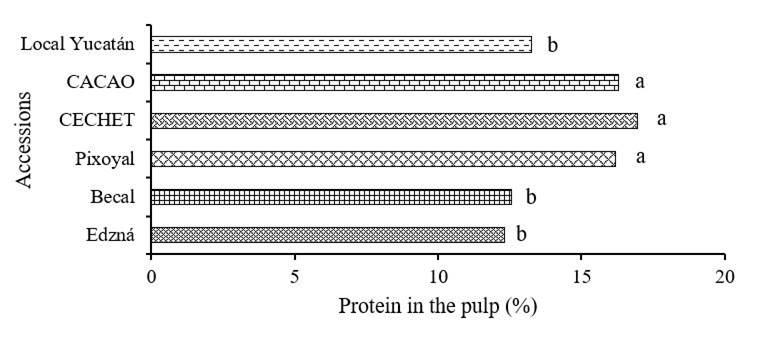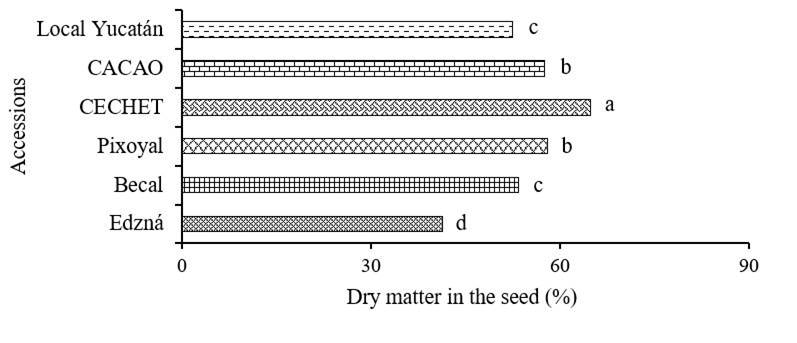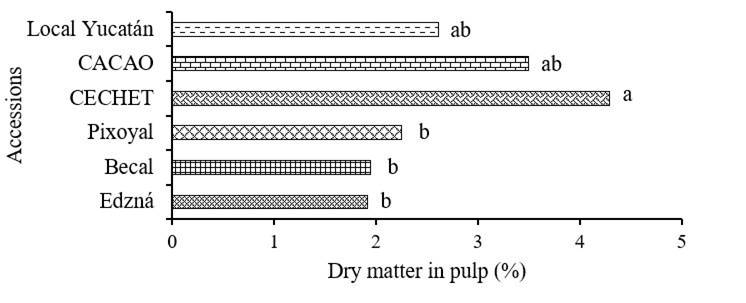Serviços Personalizados
Journal
Artigo
Indicadores
-
 Citado por SciELO
Citado por SciELO -
 Acessos
Acessos
Links relacionados
-
 Similares em
SciELO
Similares em
SciELO
Compartilhar
Revista mexicana de ciencias agrícolas
versão impressa ISSN 2007-0934
Rev. Mex. Cienc. Agríc vol.11 no.8 Texcoco Nov./Dez. 2020 Epub 13-Dez-2021
https://doi.org/10.29312/remexca.v11i8.1931
Articles
Proximal analysis of chihua pumpkins accessions in the Yucatán Peninsula
1Instituto Tecnológico de Chiná. Calle s/n entre 22 y 28, Chiná, Campeche, México. CP. 24520. Tel. 981 8272082, ext. 103. (betymonic@hotmail.com; jlruiz15@hotmail.com, rolito22@hotmail.com)
2Campo Experimental Edzná-INIFAP. Carretera Campeche-Pocyaxum km 15.5, Campeche, México. CP. 24520. Tel. 55 38718700, ext. 100 y 310.
3 Campo Experimental Mococha-INIFAP. Carretera Mérida-Motul km 25, Mococha, Yucatán, México. CP. 97454. Tel. 55 38718700, ext. 88216 y 88213. (rangel.alma@inifap.gob.mx).
4Campo Experimental Chetumal-INIFAP. Carretera Chetumal-Bacalar km 25, Othón Blanco, Quintana Roo, México. CP. 77000. Tel. 55 38718700, ext. 88411. (garcia.angel@inifap.gob.mx).
The objective of the work was to determine the content of protein and dry matter in the seed (%PROTSEMC, %MATSSEMC), shell (%PROTCASC, %MATSCASC) and pulp (%PROTPULC, %MATSPULC), and percentage of carbohydrates (%CARBCA), fat (%GRASCRU) and ash (%CENCA) in the seed of six accessions of chihua pumpkins (Cucurbita argyrosperma Huber), native to the Yucatán Península. The accessions evaluated were: Becal, Edzna, Pixoyal, Chihua local, CACAO and CECHET. The sowing was carried out in June 2017 in Pocyaxum, Municipality of San Francisco de Campeche, Mexico, in a randomized block design with three repetitions, analysis of variance and mean comparisons were performed with the Tukey test (p≤ 0.05). The experimental unit consisted of three rows of 6 m in length, separated at 2.40 m and 1.25 m between plants. For the determination of proteins, the Kjeldahl method was used, and following the process described in AOAC (2000). The CECHET accession showed higher (p≤ 0.05) %PROTESEMC, %PROTCASC, %MATSSEMC and %MATSPULC with 33.6, 14.4, 64.9 and 4.29%, respectively. Edzna, Becal, Local Yucatan presented 3.8% PROTPULC less (p≤ 0.05) compared to the CECHET, CACAO and Pixoyal accessions. Edzná presented higher (p≤ 0.05) % GRASCRU with 45.3%. Becal, presented the highest (p≤ 0.05) %CARBCA with 34.7%. The % MATSCASC of the CACAO accession (12.5% MATSCASC) exceeds (p≤ 0.05) those obtained in the rest of the accessions. There were no differences (p≤ 0.05) for the %CENCA. The accession that stood out was CECHET, with the highest percentage of protein in seed, peel, pulp and dry matter in seed and pulp. Accessions with nutritional intake for consumption were identified that can be an alternative for preparing different foods.
Keywords: Cucurbita argyrosperma Huber; biodiversity; native pumpkin
El trabajo tuvo como objetivo determinar el contenido de proteína y materia seca en la semilla (%PROTSEMC, %MATSSEMC), cascara (%PROTCASC, %MATSCASC) y pulpa (%PROTPULC, %MATSPULC), y porcentaje de carbohidratos (%CARBCA), grasa (%GRASCRU) y ceniza (%CENCA) en la semilla de seis accesiones de calabaza chihua (Cucurbita argyrosperma Huber), nativas de la Península de Yucatán. Las accesiones evaluadas fueron: Becal, Edzná, Pixoyal, Chihua local, CACAO y CECHET. La siembra fue realizada en junio de 2017 en Pocyaxum, San Francisco de Campeche, México, con diseño de bloques al azar con tres repeticiones, se realizó análisis de varianza y comparaciones de medias con prueba de Tukey (p≤ 0.05). La unidad experimental consistió en tres surcos de 6 m de longitud, separados a 2.4 m y 1.25 m entre planta. Para la determinación de proteínas se empleó el método Kjeldahl, y siguiendo el proceso descrito en AOAC (2000). La accesión CECHET mostro mayor (p≤ 0.05) %PROTESEMC, %PROTCASC, %MATSSEMC y %MATSPULC con 33.6, 14.4, 64.9 y 4.29%, respectivamente. Edzná, Becal, Local Yucatán presentaron 3.8% PROTPULC menos (p≤ 0.05) en comparación a las accesiones CECHET, CACAO y Pixoyal. Edzná presento mayor (p≤ 0.05) %GRASCRU con 45.3%. Becal, presento mayor (p≤ 0.05) %CARBCA con 34.7%. El %MATSCASC de la accesión CACAO (12.5% MATSCASC) superan (p≤ 0.05) al resto de las accesiones. No hubo diferencias (p≤ 0.05) para %CENCA. La accesión que sobresalió fue CECHET, con mayor porcentaje de proteína en semilla, cascara, pulpa y materia seca en semilla y pulpa. Se identificaron accesiones con aporte nutricional para consumo que pueden ser alternativa para elaboración de distintos alimentos.
Palabras clave: Cucurbita argyrosperma Huber; biodiversidad; calabaza nativa
Introduction
The cultivated species of the genus Cucurbita (Cucurbitaceae) in Mexico and the rest of Mesoamerica are the plants that, in general, are called pumpkins and chilacayotes (Mera et al., 2011). Cucurbita (Cucurbitaceae) is a relatively recent genus, which emerged in North America 16 million years ago and its cultivated species maintain a high genetic variation; Cucurbita pepo is the species with the greatest genetic variation, variation associated with two independent domestications, one in the north of Mexico, and the other in the Southeast of the United States of America (Eguiarte et al., 2018). In another species, Cucurbita argyrosperma, its populations in the Yucatan Peninsula represent a genetic pool differentiated from the rest of the species (Eguiarte et al., 2018).
Studies carried out on pumpkin species, especially research directed at the physical and chemical characteristics of the fruit, have received considerable attention to diversify the final products (Rössel et al., 2018). From these products, the seed can be used because they are rich in beneficial compounds for health such as polysaccharides, carotenes, mineral salts, vitamins and others (Fu et al., 2007). Vaštag et al. (2014) indicate that the largest fraction of these proteins is represented by cucurbitins. Pumpkin seed proteins are desirable ingredients in food products, exhibiting antimicrobial, anti-carcinogenic effects and alleviating the detrimental effects associated with protein malnutrition (Bučko et al., 2016).
The nutritional value of pumpkin seeds is based on a high protein content (25-51%) and a high percentage of oil (40 and 60%), 46.9% of the oil comes from oleic fatty acids, 40.5% linolenic, 17.4% of palmiotic and stearic and 0.60 to 0.75 g of monounsaturated and polyunsaturated acids (Rezig et al., 2016). Consequently, plant proteins are increasingly used as unconventional sources of protein to perform functions in food formulations (Abdel, 2006).
Protein-based ingredients from pumpkin have not yet been introduced on a significant scale into food applications and although there is a large flow of data on the functional properties of various proteins from pumpkin species, little data is currently available. It is probably due to limited information on the structural and functional properties of pumpkin proteins (Rezig et al., 2016).
Particularly in the Yucatan Peninsula, the information on pumpkins and especially on native chihua pumpkins species and their protein content is insufficient. Therefore, the objective of the present work was to determine the content of protein and dry matter in the seed, shell and pulp and percentage of carbohydrates, fat and ash in the seed of six accessions of chihua pumpkins (Cucurbita argyrosperma Huber), native to the Yucatán Península.
Materials and methods
The experiment under field conditions was carried out on a surface area near the community of Pocyaxum, Municipality of San Francisco de Campeche, Camp., Mexico, whose geographic coordinates are: 19.7333 north, -90.3583 west and at an altitude of 30 meters above sea level. In the spring-summer 2017 cycle under storm conditions, on deep red-clay soils, called Kancab or K’aancab in the classification of soils elaborated by the ancient Mayans and called Luvisols in the FAO-UNESCO classification (1970).
The study evaluated six accessions of chihua pumpkins (Cucurbita argyrosperma Huber) used at the regional level, three of them belong to the state of Campeche named: Becal, Edzna and Pixoyal, from Yucatan the Chihua local accession was included and from Quintana Roo it was added to CACAO and CECHET.
The different cultivars were sown in June 2017. A randomized complete block experimental design with three replications was used. The experimental unit consisted of three rows of six meters in length, separated at 2.4 m one from the other and 1.25 m between plants, by depositing two plants per bush in moist soil at a depth of 3 cm and subsequently, three days after emergence, thinning to one plant, respectively.
It was fertilized with the formula 27N-69P-60K by applying manually 15 days after sowing (dds) with 150 kg of diammonium phosphate (18-46-00) in a mixture with 100 kg of potassium chloride. Before the emergency, glyphosate was applied at a dose of 2 L ha-1.
Regarding the laboratory phase, all the fruits of the experimental plot were harvested at 93 da in physiological maturity stage and transported to the laboratory of the Technological Institute of China, Campeche, Mexico. Then, five fruits were randomly selected from each of the accessions evaluated. Subsequently, the fruits were dissected into the pulp of the shell, the seeds were also obtained, weighing 100 g of shell, pulp and seeds in a Highland® digital scale and later they were placed in a Memmert® natural convection oven for dehydration, they were placed in previously identified aluminum trays for 96 hours at a temperature of 65 °C.
Once dehydrated they were placed in a desiccator until cooled, weighed and ground in a Pulvex® mill. The samples, already in powder, were placed in transparent plastic bags and kept at room temperature until the moment of analysis. In this context, the work integrated the evaluation of the protein content of the chihua pumpkins accessions in the seed, shell and pulp. For the determination of proteins, the Kjeldahl method was used, using the Kjeldahl equipment and following the process described in AOAC (2000).
This method consists of three steps: a) digestion of the sample; b) distillation of nitrogen (N); and c) titration, which are described below: a) digestion: 1 g of selenium and 1 g of sample were weighed and placed inside the test tubes of the compact digestion system (Raypa MBC-12 TB 26300 700), subsequently 10 ml of H2SO4 was added to the same tubes.
The technique was standardized using a total digestion time of 3 hours and 15 min divided according to the following activities: 15 min to reach 150 °C, which was maintained for 30 min; 15 min to reach 270 °C, which was maintained for 30 min, 15 min to increase to 370°, which was maintained for 90 min (AOAC, 2000)
At the end, it was allowed to cool for 20 to 30 min to begin the distillation process. b) Distillation: at the end of the digestion, the sample, also 25 ml of NaOH and 75 ml of distilled H2O, were added to the distillation tube.
However, the equipment (N-protein flash still, Raypa DNP-1500-MP brand) adds 25 ml more of H2O H2O during the process. Previously, 25 ml of 4% H3BO3 and 3 drops of the Tashiro indicator were placed in a 250 ml flask.
Subsequently, the process was configured with a waiting time of 30 s, steam at 100% and 8 min of distillate to collect 250 ml of sample. c) Titration: the process was carried out with HCl at 0.25% N, the sample obtained from the distillation was subjected to titration until it made the first color change (slightly pink). The calculation of N obtained was carried out using the following formula.
The % protein was calculated in relation to the %N with the following equation: %protein = (% N) (6.25). Where: %N = percentage of N; 6.25= constant for vegetables (AOAC, 2000). Each variable was subjected to a variance analysis with the SAS program for Windows Version 9.0 (SAS, 2002) individually.
The comparison of means was carried out with the Tukey test (p≤ 0.05). The Shapiro-Wilk test and t-student were used for the assumptions of data normality and homogeneity of variance.
Results and discussion
Percentage of protein in pumpkin seed (%PROTSEMC)
The protein content in the seeds of the chihua pumpkins accessions is statistically different (p≤ 0.05). The accession that showed the highest (p≤ 0.05) % PROTSEMC was CECHET with 33.6% compared to Becal, Pixoyal, CACAO, Edzna and Local Yucatan, which obtained in that order 26.9, 29.6, 30.3, 30.5 and 32.7% PROTSEMC, respectively (Figure 1).

Figure 1 Percentage of protein in native pumpkin seed; means with the same letter(s) between treatments are statistically equal with α= 0.05.
The variability in the content of PROTSEMC is due to the functionality of the proteins of vegetable origin that depend on the chemical characteristics inherent to the seed (Mattil, 1973). The functional properties are the result of the physicochemical properties of proteins, which specifically influence their behavior (Hernández et al., 2014).
Percentage of protein in pumpkin shell (%PROTCASC)
The study data show that the CECHET accession from the state of Quintana Roo presented the highest (p≤ 0.05) %PROTCASC with 14.4%. Applequist et al. (2006) conducted a study on pumpkin accessions in the field and observed that an accession from the state of Campeche presented 8.6% PROTCASC; data very close to the native accession called Local Yucatán and Becal, which presented a %PROTCASC of 9.3. and 9.4%, respectively (Figure 2). Young et al. (2012) points out that the %PROTCASC of pumpkin depends on the species cultivated in the region and the conditions that are cultivated, since it has been observed that the shell of Cucurbita maxima contains more protein than Cucurbita pepo or Cucurbita mochata.
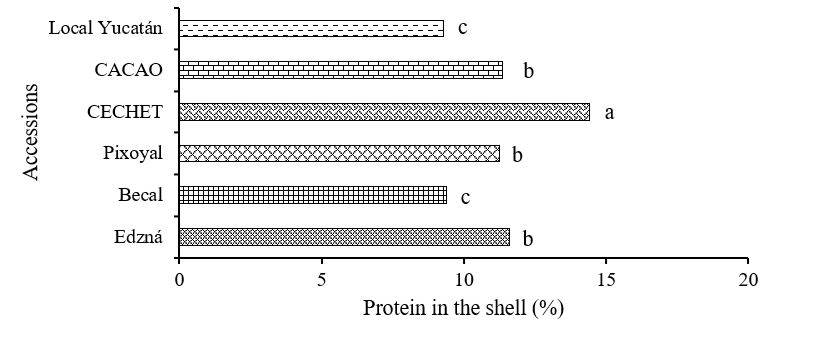
Figure 2 Percentage of protein in native pumpkin shell. Means with the same letter(s) between treatments are statistically equal with α= 0.05.
Studies conducted by Ziaul et al. (2019) reveal that there are native Cucurbita maxima pumpkins cultivars that present higher protein content in the shell compared to hybrid varieties and these differences are attributed to the differences between the species and varieties Cucurbita spp., grown in different areas of the world.
Percentage of protein in pumpkin pulp (%PROTPULC)
Studies by Kim et al. (2012) in the field, observed that a pumpkin material (C. pepo) presented an average of 1% PROTPULC. While in the present work a variation (p≤ 0.05) was obtained in the amount of% PROTPULC; al observes that Edzna, Becal, Local Yucatan presented 3.8% PROTPULC less than the CECHET, Cacao and Pixoyal accessions (Figure 3).
The variation that the CECHET, Cacao and Pixoyal accession presented in the %PROTPULC compared to the rest can be attributed to the differences in the chemical components that persist in each of them, which in turn is related to the region where it is grown (El and Mulhieddine, 2019).
Percentage of crude fat in pumpkin seed (%GRASCRU)
The %GRASCRU in the accessions was statistically different. The Edzna accession presented a greater (p≤ 0.05) amount of %GRASCRU, than CACAO, Local Yucatan, Pixoyal, Becal and CECHET with a variation in that order of 3.3, 5.6, 12.6, 13.1 and 15.1% GRASCRU less than Edzna (Figure 4).
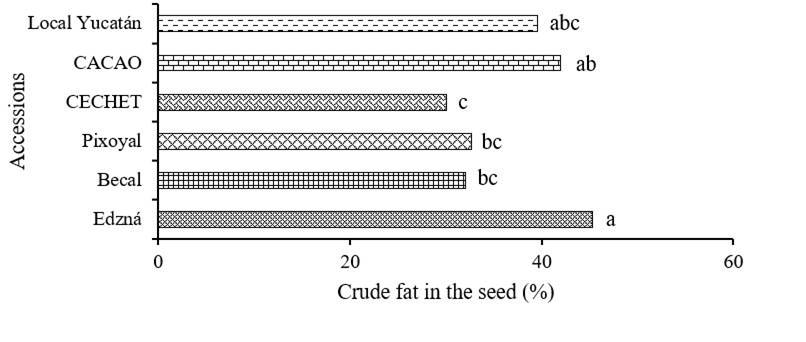
Figure 4 Crude fat percentage of native pumpkin accessions. Means with the same letter(s) between treatments are statistically equal with α= 0.05.
The results on %GRASCRU of the present study coincide with those obtained by Stevenson et al. (2007), who observed values between 36.0 to 40.1% GRASCRU in pumpkin cultivars (Cucurbita maxima D). While in the studies by Jarret et al. (2013) obtained 13.5% (24.4 to 32.9%) more crude fat in the seed than those obtained in the present work.
Among the aspects that influence the variability in %GRASCRU, it is pointed out that the seed contains different amounts of minerals such as Fe, Ca, Mg, Zn, P, K and Cu, as well as anti-nutrients such as oxalates, cyanides, thianines and phylates, which cause a variation in the % GRASCRU of the buido pumpkins (Telfairia occidentalis) (Ekpedeme et al., 1999).
Another factor that could influence the variation of %GRASCRU is the origin of the accessions, since the physical characteristics of fat and oil are dependent on factors such as the seed or plant of origin, degree of unsaturation, size of the chains of carbon, isomeric forms of fatty acids and the molecular structure of triglycerides (Lawson, 1999).
Percentage of ash in pumpkin seed (%CENCA)
In relation to the %CENCA, there were no significant differences p≤ 0.05 between the accessions (Figure 5). The highest ash values obtained in this research surpass by 1.8% that obtained by Gohari et al. (2011) in pumpkin (Cucurbita pepo), obtaining 5.3% CENCA. Belitz and Grosch (1997) indicate that among the factors that influence the variation in %CENCA is the content of minerals (P, Zn, Cu and Mg) that is given by genetic factors, climatic, cultivation practices, soil composition and fruit ripening period at harvest.
Percentage of carbohydrates in pumpkin seed (%CARBSE)
The %CARBSE of the Becal accession is higher (p≤ 0.05) than the rest of the accessions evaluated. Simultaneously in the present study, it was observed that Becal obtained a higher variation (p≤ 0.05) in the %CARBSE over Pixoyal, CECHET, Local Yucatán, CACAO and Edzná, with a record in that order of accessions of 3.2, 5.6, 11.8, 14.4 and 22.1% CARBCA (Figure 6)
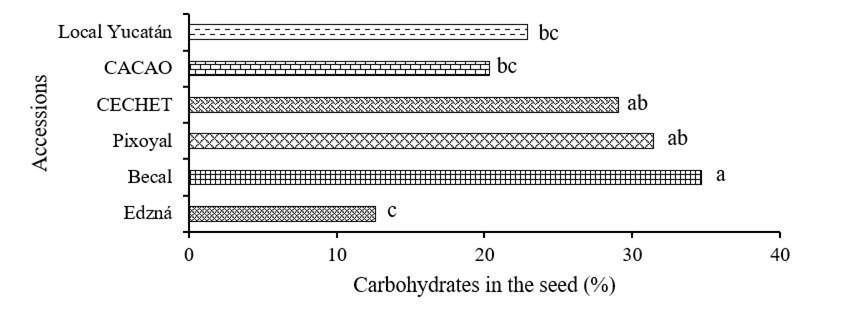
Figure 6 Percentage of carbohydrates in native pumpkin accessions. Means with the same letter(s) between treatments are statistically equal with α= 0.05.
It is possible that the %CARBSE of the accessions was related to the origin and subsequent management of the crop in Quintana Roo, Yucatán and Campeche, similar to those observed in 13 Cucurbita cultivars belonging to various agroecological regions of eastern and central Kenya, where it is shown that there is a variability in %CARBSE (Karanja et al., 2014).
Ceron et al. (2010) indicates that, according to the genetic diversity, the nutritional quality and quantity of the pumpkin seed is heterogeneous and this is verified with the results obtained in the studies carried out by Terazawe et al. (2001) when observing that the pumpkins Cucurbita maxima Duch and Cucurbita moschata Duch, as their fruits grow, differ in the content of carbohydrates (sugars) and this total sugar content of Cucurbita maxima Duch. increased gradually after 30 days from flowering, while Cucurbita moschata Duch. increased steadily during fruit growth.
Percentage of dry matter in pumpkin seed (%MATSSEMC)
The dry matter content in the seed of the native pumpkin cultivars of the region is variable, this allows some native pumpkin species to prevail in the region. For example, orthodox seeds in some cases reduce their moisture content to values lower than 10 and 15%, which allows them to survive in the face of changes in the environment and be stored for long periods (Kermode, 1997).
In this sense, in the present work an average value of 55% of MATSSEMC was observed among the pumpkin accessions. While the individual content of MATSSEMC, the accession named CECHET surpassed (p≤ 0.05) Edzna, Local Yucatan, Becal, CACAO and Pixoyal with a difference in that order of 23.5, 12.5, 11.5, 7.3 and 6.8% more than MATSSEMC (Figure 7).
Percentage of dry matter in pumpkin pulp (%MATSPULC)
In the present work, the %MATSPULC fluctuated between 1.9 to 4.3%. In this context, the CECHET accession presented higher (p≤ 0.05) %MATSPULC than Edzna, Becal, Pixoyal, Local Yucatan and CACAO with a difference in that order of 2.4, 2.3, 2.0, 1.7 and 0.8% MATSPULC (Figure 8).
On the nutritional characteristics of the pumpkin, except for sugars and acidity. The present study reveals that in the Yucatan Peninsula there are native accessions that present a greater amount of dry matter in the pulp compared to others cultivated in the region and this variation is attributed to the fact that in some of the accessions the nutritional characteristics of the pumpkin are negatively affected by the moisture content of the fruit, which is around 90% (Ortiz et al., 2008), becoming a perishable fruit, short-lived, with diluted nutrients, where the longevity of the fruit and its ability to be stored for long periods depends on the percentage of dry matter (Lacuzzo and Dalla, 2009). Therefore, the identification of genotypes with high levels of dry matter is essential to strengthen genetic improvement from an agro-industrial perspective (Ortiz et al., 2013).
Percentage of dry matter in pumpkin rind (%MATSCASC)
The values observed in the percentage of dry matter in the shell of the accession called CACAO exceed (p≤ 0.05) those observed in the Pixoyal, Becal, Edzna, Local Yucatan and CECHET accession with a variation in that order of 6.8, 5.5, 5.4, 4.9 and 4.4% MATSCASC (Figure 9).
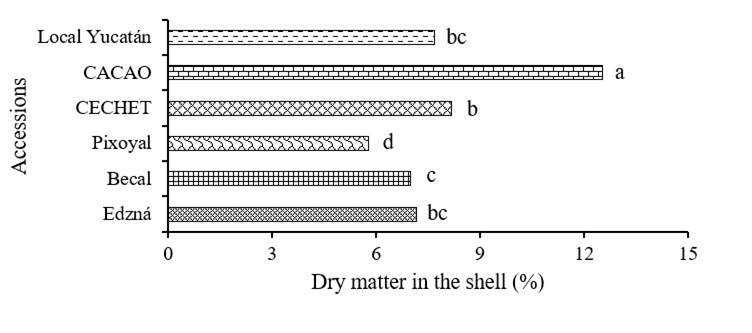
Figure 9 Percentage of dry material in the native pumpkin shell. Means with the same letter(s) between treatments are statistically equal with α= 0.05.
These results contrast with those obtained by Lorenzo et al. (2019) by obtaining 13.71% of MATSCASC with pumpkin pulp. Dorantes et al. (2016) in accessions of native pumpkin (Cucurbita argyrosperma Huber) from the state of Campeche observed values of 6.45% of MATSCASC and pumpkin pulp. Rössel et al. (2018) point out that the shell of the pumpkin is composed mostly of crude fiber (3 403 g 100 g-1 sample), carbon (19.79 g 100 g-1 sample) and calcium (30.057 mg 100 g-1 sample).
Conclusions
The nutritional content of the chihua pumpkins (Cucurbita argyrosperma Huber) accessions grown in the Yucatan Peninsula is variable. The accession that presented the highest nutritional content in the parts of the fruit was CECHET from Quintana Roo, obtaining a higher percentage of protein in the seed, shell, pulp and percentage of dry matter in the seed and pulp. Edzna de Campeche stood out in the content of crude fat in the seed. Becal of Campeche was superior to all accessions in carbohydrate content.
The CACAO accession from Quintana Roo presented better results for the dry matter content in the shell. Accessions with nutritional contribution were identified for their consumption, which in turn can be an alternative to diversify their use in the preparation of different foods.
Literatura citada
Abdel, R. M. K. 2006. Effect of pumpkin seed (Cucurbita pepo L.) Diets on benign prostatic hyperplasia (BPH): chemical and morphometric evaluation in rats. World J. Chem. 1(1):33-40. [ Links ]
AOAC. 2000. International. Official Methods of Analysis of AOAC International, 17th (Ed.). Arlington USA. 673 p. [ Links ]
Applequist, W. L.; Avula, B.; Schaneberg, B. T.; Wang, Y. H. and Khan, I. A. 2006. Comparative fatty acid content of seeds of four Cucurbita species grown in a common (shared) garden. J. Food Compos. Anal. 19(6-7):606-611. [ Links ]
Belitz, H. D. and Grosch, W. 1997. Química de los alimentos. 2a (Ed.). Zaragoza: Acribia. 1087 p. [ Links ]
Bučko, S. D.; Katona, J. M.; Popović, I. M.; Vaštag, Ž. G. and Petrović, I. B. 2016. Functional properties of pumpkin (Cucurbita pepo) seed protein isolate and hydrolysate. J. Serb. Chem. Soc. 81(1):35-46. [ Links ]
Cerón, G. L.; Legaria, S. P. J.; Villanueva, V. C. y Sahagún, C. J. 2010. Diversidad genética en cuatro especies mexicanas de calabaza (Cucurbita spp.). Rev. Fitotec. Mex. Vol. 33(3):189-196. [ Links ]
Dorantes, J. J.; Flota, B. C; Candelaria, M. B.; Ramírez, M. M. y Crosby, G. M. M. 2016. Calabaza chihua (Cucurbita argyrosperma Huber), alternativa para alimentación animal en el trópico. Agroproductividad. 9(9):33-37. [ Links ]
Eguiarte, L. E.; Rosales, H. H. S.; Redondo, B. J.; Morales, C. G.; Torres, P. L. M.; Sánchez-de la Vega G.; Mondragón, R. K. Y.; Lobo, V. A.; Hernández, M. S.; Planter, A. E.; Sauza, V. y Lira, R. 2018. Domesticación, diversidad y recursos genéticos y genómicos de México: el caso de las calabazas. Tip Revista especializada en ciencias químico-biológicas. 21(2):85-101. [ Links ]
Ekpedeme, U. A.; Bassey, A. N.; Ekaete, U. and Etuk. 1999. Minerals and antinutrients in fluted pumpkin (Telfairia occidentalis Hook f.). Food Chemistry 70 2000 235-240. Analytical, Nutritional and Clinical Methods Section. Nigeria. [ Links ]
El, K. S. B. and Multhieddine, M. 2019. Nutritional profile and medicinal properties of pumpkin fruit pulp. Chapter. Ed. 1-19 pp. [ Links ]
FAO-UNESCO. 1970. Food and Agricultural Organization of the United Nations. Clave de unidades de suelos Del mundo. Secretaría de Recursos Hidráulicos (SRH). Dirección de Agrología. México, DF. [ Links ]
Fu, C. L.; Tian, H. J.; Cai, T. Y.; Liu, Y. and Li, Q. H. 2007. Some properties of an acidic protein-bound polysaccharide from the fruit of pumpkin. Foo d Chem. 100(3):944-947. [ Links ]
Gohari, A. M.; Mehrabi, R.; De-Wit, P. J. G. M. and Kema, G. H. J. 2011. MgWor1 is involved in conidia formation, hyphal morphogenesis and pathogenicity of the fungal wheat pathogen Mycosphaerella graminícola. Book of Abstracts In: 8th International Symposium on Mycosphaerella and Stagonospora Diseases of Cereals. Mexico City September. 10-14. 32 p. [ Links ]
Hernández, S. B.; Gordillo, M. J. A.; Martínez, S. E. C. y Castro, R. J. 2014. Potencial nutricional de la semilla de calabaza (Cucurbita pepo). In: los alimentos en México y su relación con la salud. Aguilera, O. M.; Ramírez, J. A.; Reynoso, C. R. y Gómez, A. C. (Eds.). 1ª Edición. México. 191-211 p. [ Links ]
Jarret, R.; Levy, I.; Potter, T.; Cermak, S. and Merrick, L. 2013. Seed oil content and fatty acid composition in a genebank collection of Cucurbita moschata Duchesne and C. argyrosperma C. Huber. Plant. Genet. Resour. 11(2):49-157. [ Links ]
Karanja, K. J.; Mugendi, J. B.; Khamis, M. F. and Muchugi, N. A. 2014. Nutritional evaluation of some Kenyan Pumpkins (Cucurbita spp.). Inter. J. Agric. Forest. 4(3):195-200. [ Links ]
Kermode, A. R. 1997. Approaches to elucidate the basis of desiccation-tolerance in seeds. Seed Sci. Res. 7(2):75-95. [ Links ]
Kim, M. Y.; Kim, E. J.; Kim, Y.; Choi, H. and Lee, B. 2012. Comparison of the chemical compositions and nutritive values of various pumpkin (Cucurbitaceae) species and parts. Nutr. Res. Pract. 6(1):21-27. [ Links ]
Lacuzzo, F. and Dalla, C. L. 2009. Yield performance, quality characteristics and fruit storability of winter squash cultivars in sub-humid areas. Sci. Hortic. 120(3):330-335. [ Links ]
Lawson, H. 1999. Aceites y grasas alimentarios: tecnología, utilización y nutrición. Acribia. Ed. 346 p. [ Links ]
Lorenzo, H. R.; Torres, S. N.; Sánchez, S. P.; Herrera, P. J.; Mayrén, M. J. F.; Salinas, R. T.; Rafael, R. G. A. y Maldonado, P. A. M. 2019. Evaluación de las características de calidad y bromatológicas de ensilados elaborados con residuos de calabaza (Cucurbita argyrosperma). Rev. Int. Contam. Ambie. 35(4):957-963. [ Links ]
Mattil, K. F. 1973. Considerations for choosing the right plant proteins. Food product development, 7(6):40-44. [ Links ]
Mera, O. L. M.; Bye, B. R. A.; Villanueva, V. C. y Luna, M. A. 2011. Documento de diagnóstico de las especies cultivadas de Cucurbita L. SAGARPA, SINAREFI, SNICS. México. 79 p. [ Links ]
Ortiz, G. S.; Sánchez, L. J.; Valdés, R. M. P.; Baena, G. D. y Vallejo, C. F. A. 2008. Retención de caroteno total en fruto de zapallo Cucurbita moschata Duch acondicionado por osmodeshidratación y secado. Acta Agron. 57(4):269-274. [ Links ]
Ortiz, G. S.; Vallejo, C. F. A.; Baena, G. D.; Estrada, S. E. I. y Valdés, R. M. P. 2013. Zapallo para consumo en fresco y fines agroindustriales: investigación y desarrollo. Universidad Nacional de Colombia, Sede Palmira. ed Santiago de Cali, Feriva. Colombia. 299 p. [ Links ]
Rezig, L.; Riaublanc, A.; Chouaibi, M.; Guéguen, J. and Hamdi, S. 2016. Functional properties of protein fractions obtained from pumpkin (Cucurbita maxima) Seed. Int. J. Food Prop. 19(1):172-186. [ Links ]
Rössel, D. K.; Ortiz, H. L; Amante, O. A.; Durán, G. H. M. and López, L. A. M. 2018. Physical and chemical characteristics of pumpkin seeds for mechanization and processing. Nova Scientia. 10 (2):61-77. [ Links ]
SAS. 2002. Statistical Analysis System, Versions 9.0 para Windows. Institute Inc., Cary, NC, USA. [ Links ]
Stevenson, D. G.; Eller, F. J.; Wang, L.; Jane, J. L.; Wang, T. and Inglett, G. E. 2007. Oil and tocopherol content and composition of pumpkin seed oil in 12 cultivars. J. Agric. Food Chem. 55(10):4005-4013. [ Links ]
Terazawe, Y.; Masuda, R.; Yoshida, K. and Ito, K. 2001. Changes in carbohydrate composition in pumpkins (Kabocha) during fruit growth. ResearchGate. 70(5):656-658. [ Links ]
Vaštag, Ž.; Popović, L. J. and Popović, S. 2014. Bioactivity evaluation of cucurbitin derived enzymatic hydrolysates. IJABE. 8(5):445-448. [ Links ]
Young, K. M.; Jin, K. E.; Nam, K. Y.; Choi, C. and Hieu, L. B. 2012. Comparison of the chemical compositions and nutritive values of various pumpkin (Cucurbitaceae) species and parts. Nutr. Res. Practice. 6(1):21-27. [ Links ]
Ziaul, A. M.; Islam, T.; Rasel, U. M.; Jashim, U. M.; Mashiar, R. M. and Abdus, S. M. 2019. Comparative study on nutrient contents in the different parts of indigenous and hybrid varieties of pumpkin (Cucurbita maxima L.). Heliyon. 5(9):1-5. [ Links ]
Received: September 01, 2020; Accepted: November 01, 2020











 texto em
texto em 

